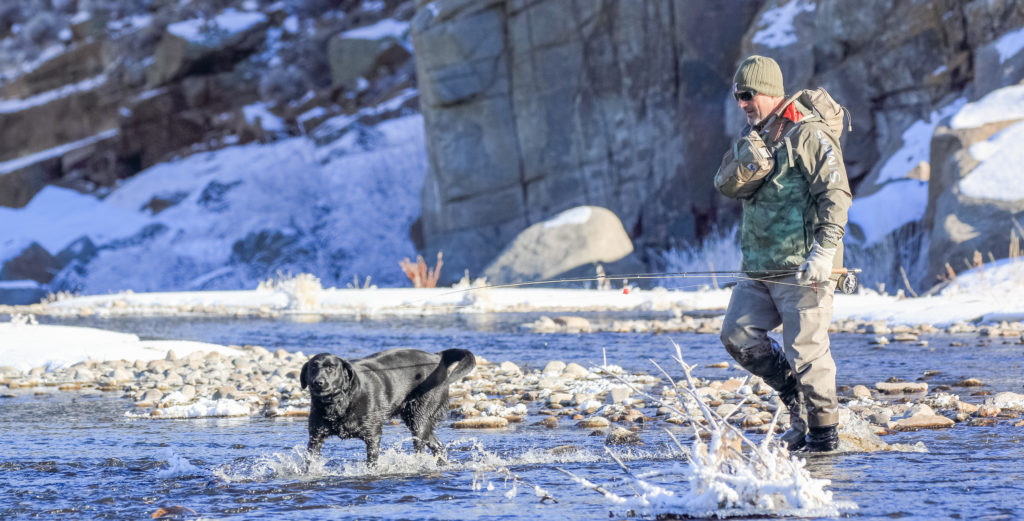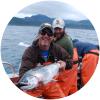“Many people think a Ferrari is beautiful but it isn’t if you compare it to a horse.” –Jim Harrison
“Horsing’s going to be tough,” said Chad Hanson as he climbed into my truck and we headed out on an icy morning in the middle of Wyoming’s winter. “The Green Mountain herd got scooped up last summer, but there should be some bands a little south of there.” Our fly fishing gear was stacked in the cab of my truck. We brought snacks. And we had our cameras. My Lab Henderson was locked in the back of my truck, behaving himself more or less. The idea was to look at some wild horses, then hit the river for a winter fishing trip. It would be great to check in on the brown trout that live in the Cardwell section near Pathfinder. We thought we’d fish until sunset. Or at least until our hands got too cold.

Chad and I had been going on early morning expeditions for many years. A professor of Sociology, Chad came to Casper to teach at the college, and immediately became obsessed with all of the things Wyoming has to offer. Skiing (both downhill and cross country), hiking, camping, mountain biking, and wildlife photography. But fly fishing took hold of him and it seemed we had lost him for most of the early 2000s.
An academic with keen concentration, Chad began to write prolifically about fly fishing. He published in the big glossy magazines and produced two books, Swimming with Trout, and Trout Streams of the Heart. It seemed like he had found his subject, then suddenly, after a camping trip near Green Mountain, he and his wife Lynn became interested in wild horses.
“They’re so social I don’t think people understand them. I’ve seen them greet each other out in the sage like old friends. I saw one mare put her neck over another horse’s neck to comfort her. It seemed like they stayed like that all summer,” he said. As a trained behaviorist, Chad looks at horses in a way I never imagined. He sees them as interconnected family groups that have woven themselves into the character of the landscape. He is a true academic, and ideas and tidbits of knowledge fly into his mind.
“Up there is Whiskey Peak,” he said, a bit jittery from several cups of coffee, “Kevin flew a hang glider all the way to North Dakota back in the 80s. There’s a nob up there. He just launched himself.”
“How did he get home?” I said.
“Beats me.”
We turned off the highway and onto Mineral X Road. Here, the BLM manages the Stewart Creek Herd of about 800 wild horses. For the last seven years, Chad and Lynn have been spending their time out among these horses, and other herds scattered around Wyoming and beyond. From that first day when they came across a small band of wild mustangs, they’ve viewed wild horses as integral parts of the landscape. They’ve been hooked ever since.
“All of my free time is spent studying these horses. We camp out among them. Lynn and I can’t get enough. We recognize them. And I think they recognize us,” he said.
But they didn’t recognize me. The first group we came upon was a band of about seven horses. There was one white horse standing apart from the rest. He was already staring us down. From my experiences with big game hunting, I knew that we had been made, and that the animals were uncomfortable with our presence. We crept through the hoarfrost with our heads down. We zig-zagged and didn’t approach the animals directly. Chad says you should kneel every so often to let them settle down. But the white stallion stomped the ground and snorted. The herd bolted and disappeared over a rise. It reminded me of the hundreds of unsuccessful stalks I had made on antelope. “They live in a different world,” Chad said. During the day, he repeated this phrase several times, always in a near whisper, as if he were talking to himself. We walked back across the snow-covered prairie to find another herd.
Mineral X Road makes a large loop through the rolling, harsh country between Rawlins and Bairoil. It’s big country. Objects appeared closer than you think they are, the vistas are disorienting. We saw horses spread out on the snowy rises, always a safe distance from the road. We decided to make one more approach before we headed off to fish. This time we were more successful. According to Hanson, the bachelor groups are easier to approach than groups with mares and foals. This time we crunched over the snow and got within fifty yards of two stallions, one of which had an interesting dappled grey coat. They manes were knotted with snow and ice, and their tails dragged in the sage. There was little wind and we were able to sit for a few minutes near the horses while they grazed. It was so quiet. Only the sound of a jet going over broke the scene.

After the horses, we drove through familiar country. There weren’t many anglers out. I had thought that there would be tons of guys out, given the sunshine. This time of year you find a lot of fishermen simply wanting to test their new gear, or do something besides watching football. But it was only in the twenties. We saw a band of ice fishing huts stretched out on the frozen reservoir. We crawled into our waders. It was refreshing to see Hanson’s old neoprene waders and his make-shift rod tube crafted from a simple PVC pipe with caps. So many fishermen are concerned with the de rigueur equipment and gadgets. But Hanson has always been a bit of a throwback. He was fishing with a fiberglass rod way before it became vogue. He used it because it was what he had. Now it’s a statement on style.
We rigged up. The river was out of its traditional riverbed. The usual places where I fish were submerged in icy current. “What’s the deal with the flow?” I said.
I released Henderson and he went galloping down to the river’s edge. A flight of wild ducks went up. The sun on the blanket of snow was dazzling, so glaring that it was almost overwhelming. Hanson and I squinted at the river. We had much difficulty getting the size 20 and 18 flies on our leaders. The canyon mouth was dark and icy. I decided I would not attempt to go in there. Back when I was hungrier, more reckless, I’d go into an icy canyon in the dead of winter, but not now. Hanson agreed.
So we stayed in the safer runs and casted for a while. I didn’t move a fish. Neither did Hanson. He picked up his camera and took photos of the beautiful light striking the water. And the way the waterdog chugged through the riffles and runs as if we were doing something of great importance. My reel froze. Ice in the guides made me pull off my gloves to break them out. The fly line was not flowing smoothly through the guides. One of the pleasures of fly fishing is the movement of line as it sings through your outfit. What’s the purpose of standing in a frozen river with frozen line? So we loaded up the dog, his coat gemmed with ice, and drove back to town, stopping only once to look down over the railing of a bridge to see if the big rainbows were up in the gravel yet, or if we had a few more weeks until they appeared, magically, or so it seems.




